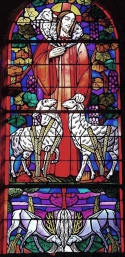Region 5: Tarn-et-Garonne

Main cities and villages along the way
- Lauzerte
- Moissac
- Auvillar
The landscape
Wake early and power it to the villages, so you have time to shower, hand wash laundry and wander before dinner. The ancient buildings, exquisite churches and quiet gardens in this stretch are more worth your time than the road.
A typical route
If you’re staying in Lauzerte, I highly recommend the campground before the village, where you can rent a yurt bed, swim in the pool and use an outdoor grill for the same cost as a dorm, about 15 euros a night. Ask the campground manager about the shortcut for hiking up the hill to Lauzerte. The city’s cobbled main square is grandiose, and the cafes around the perimeter offer a tasty local grape juice. A pilgrim’s garden a short walk from the square provides lovely views of the surrounding countryside.
In Moissac stay at the Carmelite abbey on the hill. The abbey provides simple but clean dorms, grounds with views and an gorgeous cloister full of chirping birds. If you reserve ahead, you can ask about whether they offer foot rubs to pilgrims. The city is full of churches from many eras. One, across the river, has been converted into an art space where you can sometimes watch shows.
The way from Moissac follows the shady canal, a blessed relief if temperatures are getting up in the 90s. Take a minute to soak your feet before tackling the hotter stretch to Auvillar.

One of the very best places I stayed was the 15th Century home and hotel of Gerhart and Marie-Josie, located near the Office de Tourisme in a corner of the Place de la Halle, Auvillar. You will see a clay statue of Saint James with a dove of peace over the lower roof. This place offers pilgrims’ dorms and prices for upstairs lodging in this incredibly beautiful historical building. Most valuable, though, are the conversations with Gerhart and Marie-Jo. They love their home and city, and they eagerly share meals, knowledge and stories with pilgrims in French, German and English.
Auvillar itself is one of the ‘plus beaux villages de France.’ It’s set atop a hill overlooking the green Garonne River. Wander down for a rest on grassy lawns if you can bear climbing that hill twice! The central square, or triangle, sports an ancient, round, covered marketplace, and farmers and artisans still come to sell wares on Sundays. A park just off the square offers extraordinary views of the green countryside, river and a couple of nuclear power plants in the distance. (No todo es color de rosa.)
Don’t miss
Art! Watch for signboards on walls of the mairie or office de tourisme and ask at your hostel. Performers and artists often take great art on the road in France, and you might be lucky enough to catch a play or exhibition while staying in even a small village. Most pilgrims do not pay attention to such things, so you’ve got to be proactive. But you are traveling in France, soaking in the life and wisdom along le Chemin. Don’t turn the walk into work!
In Moissac I saw a solo show by a German performer about Camille Claudel, artistic collaborator and betrayed lover of Auguste Rodin. Watching a play in a foreign language can be daunting, but for me the artistry of the performance, the body language of the actors and the opportunity to watch well-dressed audience members mingling in a happening space make watching shows in foreign countries a favorite treat.
In Auvillar I wandered into a small chapel and caught a display of hanging clay stones. A local artist had made white stones of clay and hung them on long strings strung in rows from the rafters of the church. The small, earth-toned room was damaged and mostly unadorned except for an altar cross and a blue-gold picture of the Virgin Mary, but the window light caught the white stones and created a mystic affect, like stars had dropped inside the holy place and were lighting it up from inside.
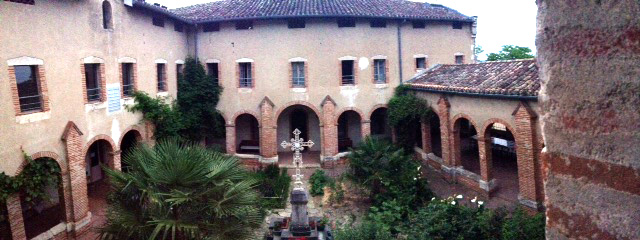
Region 4: Lot

Main cities and villages along the way
- Figeac (point of decision for variant routes)
- Cajarc
- Varaire
- Cahors
- Labastide-Marnhac
- L’hospitalet
- Lascabanes
- Montcuq (ask a French person to tell you the joke about this city’s name)
The landscape
The trail winds along the Lot River, through the Lot Valley, one of the oldest wine regions in France. It’s beautiful and lush but also distinctly more modern than some of the earlier regions. Figeac and Cahors are big cities that might prove delightful if you need to shop or annoying if you still want to pretend you’re walking through the Medieval France. You’ll find yourself following the trail along more roads, and the markers appear less frequently. By this point, you’ll probably have met many of the other pilgrims along the way, and walking with these new friends can shorten the painful stretches along hot roads.
A typical route
This region is distinct for it’s enticing variations. I highly recommend doing a little research before ploughing through the most standard route. Rocamadour, for example is a two-or-three day detour, but it’s one that a lot of pilgrims choose to make.
Rocamadour. This holy site is one of the most visited in France. It’s overrun with tourists and lined with leather-handbag sellers and overpriced ice cream, yet I still recommend the trip. The city is built in three tiers on a cliff. The lowest tier belongs to the shops, restaurants and hotels. The topmost is a castle with accessible ramparts overlooking the whole valley. There’s a monastery offering cheap lodging behind it. The second tier, built into the cliff, supports a massive church with multiple chapels that hold mass in various languages throughout the day. Two nuns live on this level and also host pilgrims.
The stained glass window in the Chapelle de Saint-Jean is one of my favorites of the whole trip. The black statue of the Virgin Mary, though, is the draw for most visitors. Those praying at Rocamadour are said to receive miracles and revelations. I can say for my own experience that this was true.
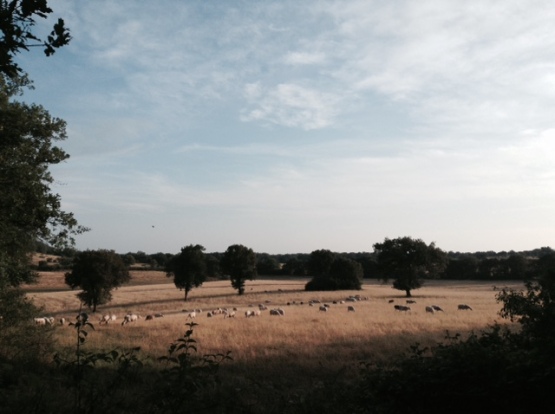
Usurped symbols

James, “Son of Thunder”, stepped out of a boat and away from his former home and livelihood in response to just one call from Jesus Christ.
James became one of the close 12 disciples who followed Jesus everywhere. For three years they traveled through villages and towns, teaching, healing and attracting crowds of thousands to hear the “good news” recorded in the four gospels.
Once, thunderously angry at a village’s rejection, James suggested calling down “fire from heaven” on the unhappy villagers. Jesus rebuked him, explaining further in some manuscripts: “… the Son of Man came not to destroy people’s lives but to save them.”
James walked so closely with Jesus, he was one of just three followers to witness a private revelation of Jesus’ identity.
The last record of James’ life in the Bible was his martyrdom by Herod. In those days the newly labeled “Christians” or followers of “The Way” had traveled from Israel as far as Phoenicia, Cyprus and Antioch, peacefully spreading the good news “which shall be for all people” of new life and salvation from sin through Jesus Christ. Following Jesus’ command and Stephen’s example, early believers died defending the message – but not themselves. James was probably the first of the 12 disciples to be killed.
With these credentials, James presented a natural candidate for the symbol of a major European pilgrimage and holy site. But for Medieval minds and purposes this story was not enough.
Legends spread that James – before and after death – traveled to Spain (even though the apostle Paul wrote after James’ death that no disciple had yet gone there). Other legends variously explained the burial of James’ body in Santiago, evidenced by a hermit’s vision of a bright light and a bishop’s revelation.
A later legend claimed James appeared fighting on a white horse during a religious battle. Thus, the disciple who learned peace from Jesus’ mouth was given the title “Moor-slayer.” Among Spanish crusaders, “¡Santiago, y cierra, España!” became a battle cry.
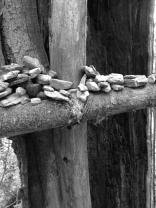
Nowadays, that part of history is not lauded on the Way of Saint James, but some older pictures still portray the saint on a white horse and wielding a sword. More notably, crusader crosses mark the trail from start to finish. I’ll never understand how a symbol of Christ’s self-sacrifice got usurped to represent the bloodshed of nonbelievers, but I don’t want to forget that it happened. I want to see those old reminders that inspire me to do my research and try to understand the messages of the world around me.
That said, I am troubled to see that the cockle shells sold at the Le Puy sacristy are still being painted with a red cross and sword.
In France, I went to church almost every Sunday, and it was a joy to sing gusty praises of “l’Agneau de Dieu” without analyzing the messages preached. Now I’m back in English congregations and troubled once more. Too often I hear messages more based on culture and extrapolation than on the actual words of the Bible, especially Jesus.

I’m also troubled that it’s common today to discuss the past with disrespect for our ancestors as if that could separate us from their mistakes and explain their evil… as if that could ensure we’re less fallible.
I’m not just talking about religion, of course. I wish I could say with confidence that our generation cares more than those Medieval masses about the accuracy, motivation and affects of our popular ideas and narratives. But those people, if they were educated, probably couldn’t even check facts in their own languages. We can check them in at least 90.
I wonder, sometimes, what ideas pass under our noses without proper inspection. I hope, more and more, that we human beings with beating hearts and working brains will not leave meaning-making to the pundits.
I hope, more and more, we will design our own arguments, beliefs and art.
Pilgrim’s Progress, part 4: Beginnings and endings

The Saint James Way is like a river with tributaries springing up all throughout Europe and running together here and there before finally joining completely at Santiago and dumping into the ocean at Finisterre. I indulge in this metaphor because on the Way you feel it: You are a droplet belonging to a much bigger body.
We flow the same direction at only slightly different speeds. Though we might never meet some of the people traveling parallel, we feel a bond for the larger whole. When we sit down to dinner together, we relax. When we cry in front of each other, we don’t look away.
This is probably because our needs are real and shared. One woman told me how she was crying quietly by herself in a beautiful old church because she didn’t understand the French schedule and had found nothing to eat all day. (Churches are more dependably open than restaurants and shops in rural France.) Someone noticed her tears, and though she hardly knew enough words to explain her need, she soon had a full meal of snacks from other pilgrims’ packs. A pilgrim priest, Father Patrick, who spoke only French and smiled a lot, walked with her to her gîte.
I told her that I, too, had cried in front of others, and that also had to do with lack of food.
Another pilgrim told me told me he’d also cried and almost quit after the first several hundred kilometers. Maybe that is the testing point. “The Way is not always so nice,” he said. “Sometimes it punches you down and kicks you in the face.”
Yet sometimes in our points of weakness we find ourselves carried by the flow. After my bag was stolen, the story became a legend of our stream, and people started looking out for the American with the big hat. After one jolly dinner at which I never mentioned the pack, several women offered me their own clothing. Another time a man stopped and opened his pack during a downpour to outfit me with a poncho. One woman checked to make sure I had the money to get home. Hostel owners were unfailingly generous, but that was true before losing the pack. To me, though, the most amazing of all the French kindnesses was that not one person ever said I should have known better.
Because of this general magnanimity, I felt like I’d washed up on dry land when I arrived finally in Saint-Jean-Pied-de-Port and shared a hostel with tourists and newly beginning pilgrims. They bragged, flirted and refused to loan me a phone charger in ways that contrasted so strongly with encounters I’d had before, with the people who’d helped me take off my shoes and bandaged my blisters. I had to remind myself these newcomers were not so different. They were just at a different stage in the journey. They might not yet have lost and gained everything. They might not yet have cried in front of someone who didn’t look away.

That last night in Saint Jean, though, I found a few old/new friends and went to the cathedral for a special evening mass. Father Patrick, the pilgrim priest, was another person who sent out ripples of stories during our season of the Way. He was traveling from Le Puy to Santiago and holding mass at every stop, delivering messages that were simple but memorable, as one pilgrim explained. Once, for example, Father Patrick had spoken about the Lord’s Prayer, saying it contained everything needed in any prayer, but you had to think about the meaning of the words – and you had to listen.
They might have also said that, though he was young, he had three completely different sets of smile wrinkles: one set over his forehead for the surprised and amused smile, a second on either side of the mouth for expressed mirth, and a third branching out from the eyes for the smile that was most tender and kind.
Though we traveled parallel for many days, Father Patrick and I didn’t cross paths till that last day of my journey. There, like a gift, he preached a message about Jesus calming storms. “Do not worry,” he said. “God is with you.” We closed with a spontaneous group prayer and gorgeous a cappella in the great stone cathedral.
The next morning, my fellow pilgrims began the brutal ascent into the Pyrenees, and I got on a train heading back toward Paris.
Pilgrim’s Progress, part 3: Outrage and expression
“No!” I cried, and again, “Non!” In case any French listeners hadn’t understood.
I stood in the middle of the road leading from Eauze to Nogaro and waived the lime green rain cover, all that was left of the full backpack I’d left near the fountain just 5 minutes before. I was wearing a pink tank, a short purple wrap skirt, my boots, jacket, a wide-brimmed hat and my money belt, my sole remaining possessions on this pilgrimage across France.
My hysteria attracted a small crowd, which was what I wanted since I didn’t know how to resolve my own crisis. Within a day, the entire town of Manciet knew of my distress, and an effective few rallied to my aid. I even saw an elderly gentleman in matching pale blue slacks, sweater and cap combing back streets and ditches with his cane. I was at the time driving around checking dumpsters with three joke-cracking gendarmes.
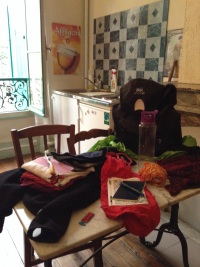
I left Manciet two days later with a full heart and pack – a t-shirt and toothbrush, not to mention almost-free food and lodging from Monique, trousers and a mini rucksack from Colette, a guide from Jacques and a notebook and pen from George. I don’t initiate the story of the theft, but it precedes and follows me along the way. Many kind pilgrims have reached into their packs and pulled out clothes or gear they saw I needed, and gîte owners have insisted on giving me food or discounts. What’s more, those girls playing at the fountain found my iPod in the grass. The thief, who was seen grabbing the pack and getting into his buddy’s car, must have dropped it out of the pack in his rush.
Because of all this extraordinary goodwill and grace, it took about three days for outrage to set in. What’s gained by the theft of a pilgrim’s pack? Not much I’d guess.
This is what is lost:
- Changes of shirt, panties, bra and socks. Any pants at all. Shower sandals.
- Two beautiful dresses (one, due to the shopping spree, new with embroidered lace, the other a hand-fitted favorite).
- The medical aids to care for blisters, etc., sunscreen.
- Obscure herbal meds for keeping stable with celiac disease.
- All toiletries and my natural-products, no-animal-testing makeup.
- Tampons and pads at the relevant moment on the weekend when all shops were closed. (Review item one.)
- Mementos, patches of countries across oceans, the knife found on Mt Baker, the pill tin from Uzbekistan, a favorite necklace of no real value, the scallop shell from the Amis de Saint Jacques in Le Puy.
- Cool, well-used gadgets, solar light, silk bedsheets, etc.
- A $300-three-years-ago computer, not worth much except to me!!!!! Yes, I have backups, but I could choke at the loss of recent writing, research and beautiful photos
- Time sitting in hostels and sports bars, coaxing weak wifi to cooperate for calls to banks and changes of dozens of passwords.
- Money, I needn’t bother tallying the cost of replacing necessities because I can’t even withdraw money anymore without a hoopla of security measures, so I have in hand just enough for a few days food and lodging at a time.
- My journal and about two dozen written and mostly stamped postcards and letters.
- Chèvre, may it spoil in their bellies, causing gaseous discomfort.
“How can you continue now?” a few hikers asked.
How could I not? Though I carried only a little, I felt the weight of each gift, of each kind word and prayer or request for prayer. I wasn’t just finishing the way for myself now. I was doing it for all those who helped me along the way. And, weirdly, I was also doing it for the thieves, whoever they are.
Today I have one day, 28 km, to go. I, personally, do not feel much kindness or mercy toward those thieves even now, but I know someone who does, someone who lost more than I did. So, God, if my journey or losses buy such favors, I ask for those thieves the strength to resist future evil impulses, the hunger for good and lives of renewed joy, generosity, freedom and lightness of being.
Pilgrim’s Progress, part 2: Gains and losses
Three trains, two busses and about 24 hours after deciding to return to the Way of St. James, I hit the trail again.
It was 7 p.m., but the sun wouldn’t set till after 9, and I’d made a reservation for a gite 10 km past Lectoure. Hiking so late meant I had the trail and my thoughts to myself. What was the purpose of my pilgrimage now? Before I’d sought rest, but since leaving Rocamadour, I felt a new fire in my belly, the strength for greater ambitions. Thunder boomed overhead, and I wondered if God had new plans for me too.
The next day I hiked around 40 km from Marsolan to Montreal du Gers. My pack was heavier than ever due to the impulsive shopping spree in Agen, but my heart and steps were light.
The next day I was packing close to 40 lbs. The pack, a brand new Osprey “anti-gravity” in burnt orange, was already heavier than most other people’s since I’d brought my computer and I like my creature comforts. But that day I packed it with wet, just-washed clothes and loaded up on several days’ of hiking goodies in Eauze. Oh, but those dried fruits and nuts, the chanticleer apples and especially that chèvre were worth their weight!
Still, I wondered at my newfound strength. Could something have happened in Rocamadour? Could God have healed me of celiac disease, that source of daily fatigue these last 8 years, for example? I didn’t form any judgments, but I listened to my iPod with joyful affinity as Christian exclaimed:
“Thus far did I come laden with my sin;
Nor could aught ease the grief that I was in,
Till I came hither; what a place is this!
Must here be the beginning of my bliss?”
By 3 p.m. And 26 km, passing through the tiny town of Manciet and finding everything closed, I was a little less skippy. Some teen girls lounging at a spring-fed fountain told me I had to go back up the hill to the church for drinking water. I groaned, walked to the road, dropped my pack behind a large flower pot and took the hill at a jog.
I marveled again at this new feeling of ease. “Keep this going, God,” I’d prayed earlier that day. “Whatever burden I lost in Rocamadour, let it stay there. Keep me light.”
When I returned to the public fountain my pack was gone.
Pilgrim’s Progress, part 1: Detours and deviations

Two days after writing that post about “finishing the race” I lost the will to keep walking. The change happened suddenly with the answer to a question. I, like many others on the Camino, had been praying about future choices, and when understanding came I lost my sense of meaning in walking.
It was hot, 90 degrees. I had new blisters from my new insoles. And, what with celiac-induced illnesses and fatigue – Saint-Jean-Pied-de-Port was indeterminably far away.
What’s more, I’d heard of a place called Rocamadour, where questions were answered and prayers granted. The city was built on a cliff in three tiers, castle, church and commerce. At the center were seven chapels and a black statue of the Virgin Mary. I could have walked there earlier on the way, but I didn’t know about the detour route, and at this point The holy site was more than 100 km behind me. Yet it was also the only place I could happily picture ahead of me.
The day before I’d walked 32 km, dragged along by a hiker I met that day who first enjoyed my company and later realized I was in danger of fainting on the road. “Never again will I hike over 30,” I’d sworn to myself repeatedly.
To the dismay of the pilgrims and hosteleros who told me St. Jacques was the other direction (but with the encouragement of a friend who reminded me it was for freedom Christ set me free), I hopped on a bus and three trains, walked 4 km and reached the cliff-side road leading to Rocamadour shortly before sunset.
It is possible to stroll to Rocamadour along a cliff top road and drop down into the city by elevator, but that is not the pilgrims’ way. Pilgrims walk down into the valley toward the lowest tier, taking in views of the castle tower, ramparts and church walls growing like flowers out of the cliff. Below the road curved past now-closed shops of fois gras and leather handbags toward the base of a great stone staircase.
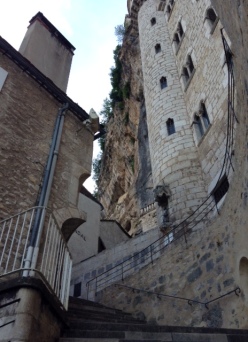
Pilgrims throughout history have taken the 216 steps on their knees, one sign read. Many famous people had come there on pilgrimage, another read. I just walked up, but I felt the holiness of the climb, like Christian’s moment ascending the hill to the cross where he loses his burden.
My pack weighed about 35 lbs since I’d splurged on a shopping spree at one of the train transfers. At a grocery store at the same stop a woman had noticed my scallop shell and asked if I was a pilgrim. When I said yes, she kissed my bag where a rosary hung and spoke to me for a long, mysterious time in French. Then she gave me some food and a slip of paper with her name, Renee, and asked me to pray for her. I said I would.
Climbing those stairs I wondered if I could still call myself a pilgrim if this was my last stop.
The next day I attended a string of religious services in French and even something Slavic. The most understandable message was a stained glass picture of Jesus wearing a blazing red robe and a knowing smile as he patted the head of a sheep. He looked more Middle Eastern and clever than he generally does in windows, and the picture gave me comfort. During one mass the nuns I was staying with pushed me forward to receive a pilgrim ‘s blessing.
After mass I wandered and wondered what to do next. I ate and felt ill, as is not unusual, and climbing the 216 steps required a couple of stops. An American couple, Linda and Biff, had stopped and prayed for me for guidance in my next choice of direction, and now I wondered what that could be. Hunkering down somewhere to write seemed sensible, but I’d come on this pilgrimage partly to escape from some of those old writing projects, and I didn’t feel ready to go back.
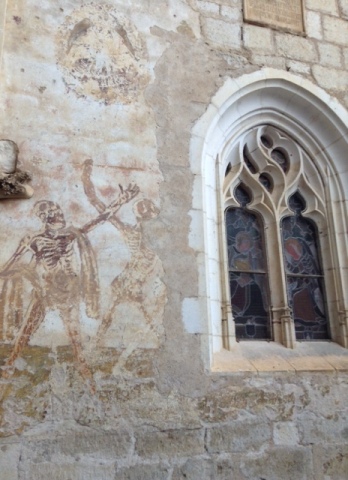
I prayed delirious gibberish at one of the chapels, then crashed at the hostel mid afternoon. When I awoke I knew I should ask to book another night. I should start researching my next location. I should do a lot of things, and I would do none of them. For a reason I could not explain all I wanted was to go back to finish the walk toward St. Jacques.
I went up to the top of the cliff along the Way of the Cross, stood on the castle ramparts overlooking the whole valley and watched as purple storm clouds blew in overhead. When thunder rumbled, I started back toward the hostel. The smell of dust filled my lungs as the wind picked up. I had to pass through a stone corridor, and the wind blew a heavy wooden door shut in the arched gateway in front of me. I pushed it open and passed through, hearing it slam. A few seconds later it banged open as the wind switched directions. Dry leaves swirled around me in a dust devil, then another. The wind switched directions several times before I reached the hostel, and big droplets dampened my green cardigan.
Then the downpour began, and a hostelero ran inside after me with a box of wine and other supplies for the evening dinner with the nuns.
“Morning rain doesn’t stop the pilgrims,” he said.
Region 3: Aveyron

Main cities and villages along the way
- Aubrac
- Saint-Chély-d’Aubrac
- Saint-Côme-d’Olt
- Espalion
- Estaing
- Golinhac
- Espeyrac
- Sénergues
- Conques
- Noailhac (as part of an alternate route)
- Decazeville
- Livinhac-le-Haut
The landscape
This stretch of the way has less elevation change than before, and the landscape is still fairly rural. Most often the way follows farm roads through fields and sometimes forest paths full of chestnut trees. Frequent low hills provide lovely views of the river Lot winding through country villages and fields. An abundance of Medieval villages and churches provide lovely stops every few miles.
A typical route
It’s useful in this region to research ahead and plan which villages you can’t possibly miss because there are so many lovely possible stops and detours. In one convent off the beaten path live nuns who make famous chocolate.
Don’t miss
Conques is a major destination for many pilgrims and tourists because of the steal-your-breath-away Medieval village and high forested hills all around. The Abbey-Church of Saint-Foy is a gem of 12th century Romanesque architecture, and it runs a unique and rigorous schedule of prayers and activities. The brothers present a pilgrims’ benediction every evening, and sometimes pilgrims read scripture in multiple languages. Afterward, a brother or the abbot hosts a chuckle-inducing explanation of the tympanum decoration over the main church doors, which depict contrasting lifestyles in heaven and hell. Finally, there’s an evening service of organ music, and paying tourists are allowed into the upper floor for a perimeter tour of the column capitals, each uniquely carved in patterns and figures. After all that came before, though, and with the thundering chords of “House of the Rising Sun” echoing in the vast church, it’s hard to study minutia. It’s enough to just walk around, jaw hanging, and wave across the church at travelers you’ve met along the way.

Walk Gently
 I’ve always loved Paul’s outburst to the Corinthians, urging them to “run in such as way as to get the prize.” But in these last few days I’ve been thinking about that in a new light.
I’ve always loved Paul’s outburst to the Corinthians, urging them to “run in such as way as to get the prize.” But in these last few days I’ve been thinking about that in a new light.
I tried to step up my game last week, wanted to keep up with the European 60-year-olds, and pulled a couple of 20-miler days with something like a 30-pound pack, food and water included. I did OK, rubbed some new blisters, sweat out any remaining toxins and had only one hysteria breakdown when I couldn’t find gluten free food in the small no-restaurant, no-grocery-store village where I’d stopped for the night. All in all, I thought I’d stepped up to a new level. But then my feet wouldn’t stop hurting.
After a day of rest and a short Monday, I was still hobbling in flip-flops, and I discussed the problem with some veteran walkers. “Take another day off,” they advised, “or get a taxi to carry your bags.” To my grimace, they added, “If you injure yourself now, you won’t finish.”
The I-haven’t-yet-checked stat backing up their warning was that only 3% of pilgrims leaving Saint-Jean-Pied-de-Port on the French Way actually make it to Santiago. Yikes…
I dumped some extra weight (down to just one hiking outfit now) and took another slow day. Today I’m resting in a yurt in a campground with a swimming pool, a trampoline and trees. Not bad.
I think about John Bunyan’s Pilgrim and his progress sometimes. Am I getting distracted, having too much fun on this journey toward the cross? Or are fun and rest part of the pilgrimage too?
My conclusion is that, more often than not, it’s better to stop, bandage the feet and call a friend. I want that prize, yes, and that’s why I’m making sure I stay in shape to finish.
Loving the French

The French are a delightful, friendly people who love to engage, make little jokes and walk down and back up very long hills just for bouquets of flowers. Indeed, I wish I knew the language and culture better than I yet do, but for now here are a few tips on loving the French:
Say hello
French people say hello all the time but only once a day to each person. Be attentive! Say, “Bonjour!” when you first meet anyone, when you enter a shop and even when you pass an elderly couple (or anyone) in the street. Always say hello to waiters or shopkeepers before anything else. The second time you see someone, it’s nice to say, “Ça va?” And if you see someone in the evening, you can say, “Bonsoir,” even if you’ve already said, “Bonjour.”
Get used to French time
Rural French shopkeepers tend to open from around 8 a.m. – 12 p.m., close for lunch, then open again from around 3 – 7 p.m. Sundays they might close entirely or just open for a morning window.

If you find this annoying, ask the shopkeeper who runs the place morning to night, seven days a week, and maybe you will suggest he or she should close more often.
Use and buy graciously
I haven’t asked, but I don’t think the American motto of the customer always being right carries over to France. If you want to try on a shirt, ask first. If you stay the night at a hostel, fold the linens you used and wash and dry all your dishes.
Laugh
You can tell a French person from a distance by the smile wrinkles. Crows feet sprout from even many of the young. While Americans might stretch their cheeks outward when they smile and get those vertical cheek lines, the French tend to smile upward, squinting their eyes into mirthful little half-moons. The lips, puckered a bit to make the tricky nasal sounds, might curve up or down or twist both ways. I’m suspecting a capricious sense of humor, but I haven’t figured that out yet.

What I have noticed is that they love to talk about others. I have just to sit in a restaurant, and already several pairs of eyes are usually studying me and sometimes quietly muttering possible nationalities. When I order my food, conversations about gluten intolerance ripple outward. Once, after just surviving a stressful string of telephone reservations, the other guests at my hostel began repeating my script – “Je m’appelle Lainie. Je suis une pèlerine.” – hyper slow and giggling.
When I made sounds of indignation (I am so articulate), they laughed even louder and told me I spoke really good French. It was not true, but it was, somehow, sweet.
I love the French.
